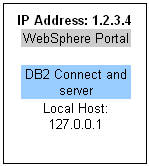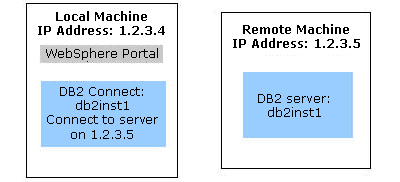Plan for DB2
See also
- Install DB2
- Create databases and users for DB2
- Transfer DB2 manually
- Transfer between databases manually
- Verify database connections
Before you begin:
This section is designed to give the IBM DB2 Universal Database Enterprise Server Edition database administrator an overall picture of IBM WebSphere Portal database requirements.
- Review the Configuring databases topic
- Ensure the database you plan to use is supported by WebSphere Portal v6.0.
Plan
After the database software has been installed, create the required databases and users and grant the proper privileges to those users.
If WebSphere Portal V6.0 and an earlier version of WebSphere Portal coexist, the database user IDs for WebSphere Portal V6.0 must be different than earlier versions to avoid conflicts during installation.
If the two versions of WebSphere Portal coexist on different databases, using the same user ID will not cause conflict.
The Feedback function is not configured by default. It must first be turned it on by following the steps in Enable logging, otherwise the Feedback tables will not be created in the new database.
DB2 Content Manager Runtime Edition is a data repository that runs on DB2 to store data for applications such as Personalization, Document Manager, and Web Content Management.
DB2 Fix Packs 10/11
If you are using DB2 Fix Pack 10 or DB2 Fix Pack 11, complete the following steps prior to database transfer. This fix should be applied to both the client side and server side of the DB2 installation. Failure to follow these steps will cause the database transfer to hang at the task action-process-constraints.
- Locate the following file:
- UNIX:
/home/db2inst1/sqllib/cfg/db2cli.ini
Windows:
db2home/sqllib/db2cli.ini
- Edit the file by adding the following to the end of the file:
[COMMON] DYNAMIC=1An empty line is required after the dynamic=1 at the end of the file.
Databases
The following table demonstrates the information each application will store in the databases.
Application Database Name Instance* Function Space considerations WebSphere Portal release
community
customizationdb2inst1 Information about user customization, such as Pages, and user profile and login information. Space required depends on the number of WebSphere Portal users and portal objects, such as pages and portlets. Member Manager wmmdb db2inst1 Used if the data is not stored on the WebSphere Portal database. Stores information about users and groups. Dependent on the configuration of users, groups and their relationship, or only additional attributes are stored The amount of this database depends on the number of Users and groups you are storing within the database repository. If the user repository is an LDAP this database is not used. Document Manager
Personalization
Web Content Managementjcrdb db2inst1 Documents, personalization rules, personalization campaigns, document library config info. Space required depends on the size and number of documents created and uploaded by the Document Manager, the number and size of Personalization rules and campaigns, and the number and size of items and elements created in Web Content Management . Feedback fdbkdb db2inst1 Database space required depends on site traffic. The amount of data that is logged per login-enabled page can vary. Likeminds lmdb db2inst1 Contains recommendations displayed to users when their interactions with the Web site have been analyzed and predictions generated. Space required depends on the amount of traffic to the site.
- The WebSphere Portal architecture allows each of these databases to exist in one or many instances. However, the recommended architecture uses the default instance (shown above as db2inst1) that is created by the DB2 installation program).
Users
The following table demonstrates the number of tables and types of objects owned by each user. The WebSphere Portal architecture allows each of the following users to exist in the same database.
All tablespaces will be approximately 2.8 GB by default. The size will increase with the use of the DB2 Content Manager Runtime Edition function.
Application Database user placeholder Recommended name Function WebSphere Portal releaseusr
communityusr
customizationusr<none> Core users. Will own approximately 130 tables for each domain. Owns WebSphere Portal core objects, which includes tables that store the user customizations made to Pages. DB2 Content Manager Runtime Edition icmadmin <none> DB2 Content Manager Runtime Edition user. Will own at least 1130 tables; the number could be higher depending on usage. Member Manager wmmdbusr <none> Member Manager user. Will own approximately 35 tables. Owns the Member Manager objects, which includes the tables that store login information about WebSphere Portal users. Feedback feedback <none> Feedback user. Will own approximately 50 tables used for logging site and personalization usage. Likeminds lmdbusr <none> Likeminds user. Will own approximately 15 tables used to hold the web site usage analysis routines and recommendation text.
DB2 architecture
In a local database environment, WebSphere Portal and DB2 are installed on the same machine.

In a remote database environment, WebSphere Portal and a DB2 Connect are installed on one machine (the local machine). The DB2 server is installed on a separate machine (the remote machine).
Remote Database Environment...

Next steps
You have completed this step. Continue to the next step:
Parent topic:
Planning for databases